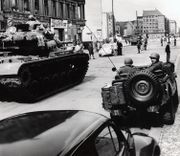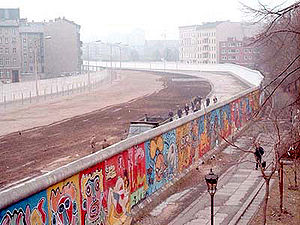Checkpoint Charlie
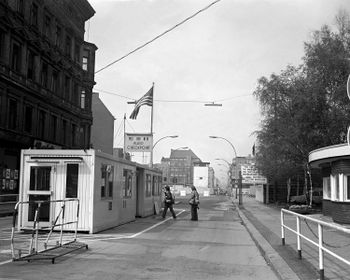
Checkpoint Charlie "Checkpoint C" was the name given by the Western Allies to the best-known Berlin Wall crossing point between East Germany and West Germany during the Cold War.
The Soviet Union prompted the erection of the Berlin Wall in 1961 to stem the flow of Eastern Bloc emigration westward through what had become a "loophole" in the Soviet border system, preventing escape over the city sector border from East Berlin to West Berlin. Checkpoint Charlie became a symbol of the Cold War, representing the separation of east and west, and—for some East Germans—a gateway to freedom. Soviet and American tanks briefly faced off at the location during the Berlin Crisis of 1961.
After the dissolution of the Eastern Bloc and the reunification of Germany, the building at Checkpoint Charlie became a tourist attraction. It is now located in the Allied Museum in the Dahlem neighborhood of Berlin.
Contents |
Background
Emigration restrictions, the Inner German Border and Berlin loophole
By the early 1950s, the Soviet approach to controlling national movement, restricting emigration, was emulated by most of the rest of the Eastern Bloc, including East Germany.[1] However, in occupied Germany, up until 1952, the lines between East Germany and the western occupied zones remained easily crossed in most places.[2] Consequently, the Inner German border between the two German states was closed, and a barbed-wire fence erected.
Even after the closing of the Inner German border officially in 1952,[3] the city sector border in between East Berlin and West Berlin remained considerably more accessible than the rest of the border because it was administered by all four occupying powers.[2] Accordingly, Berlin became the main route by which East Germans left for the West.[4] Thus, the Berlin sector border was essentially a "loophole" through which Eastern Bloc citizens could still escape.[3]
The 3.5 million East Germans that had left by 1961 totaled approximately 20% of the entire East German population.[5] The emigrants tended to be young and well educated, leading to the brain drain feared by officials in East Germany.[6] The loss was disproportionately heavy among professionals—engineers, technicians, physicians, teachers, lawyers and skilled workers.[5]
Berlin Wall constructed
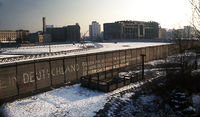
The brain drain of professionals had become so damaging to the political credibility and economic viability of East Germany that the re-securing of the Soviet imperial frontier was imperative.[7] Between 1949 and 1961, over 2½ million East Germans fled to the West.[8] The numbers swelled during the three years before construction of the Berlin Wall,[8] with 144,000 in 1959, 199,000 in 1960 and 207,000 in the first seven months of 1961 alone.[8][9] The East German economy was on the verge of collapse.[9]
On August 13, 1961, a barbed-wire barrier that would become the Berlin Wall separating East and West Berlin was erected by East Germany.[7] Two days later, police and army engineers began to construct a more permanent concrete wall.[10] Along with the wall, the 830 mile zonal border became 3.5 miles wide on its East German side in some parts of Germany with a tall steel-mesh fence running along a "death strip" bordered by bands of ploughed earth, to slow and to reveal the prints of those trying to escape, and mined fields.[11]
The Checkpoint
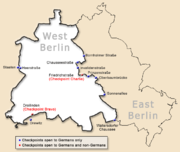
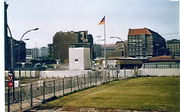
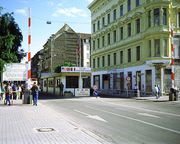
Checkpoint Charlie was a crossing point in the Berlin Wall located at the junction of Friedrichstraße with Zimmerstraße and Mauerstraße, (which for older historical reasons coincidentally means 'Wall Street'). It is in the Friedrichstadt neighborhood. Checkpoint Charlie was designated as the single crossing point (by foot or by car) for foreigners and members of the Allied forces. (Members of the Allied forces were not allowed to use the other sector crossing point designated for use by foreigners, the Friedrichstraße railway station).
The name Charlie came from the letter C in the NATO phonetic alphabet; similarly for other Allied checkpoints on the Autobahn from the West: Checkpoint Alpha at Helmstedt and its counterpart Checkpoint Bravo at Dreilinden, Wannsee in the south-west corner of Berlin. The Soviets simply called it the Friedrichstraße Crossing Point (КПП Фридрихштрассе). The East Germans officially referred to Checkpoint Charlie as the Grenzübergangsstelle ("Border Crossing Point") Friedrich-/Zimmerstraße.
As the most visible Berlin Wall checkpoint, Checkpoint Charlie is frequently featured in spy movies and books. A famous cafe and viewing point for Allied officials, Armed Forces and visitors alike, Cafe Adler ("Eagle Café"), is situated right on the checkpoint. It was an excellent viewing point to look into East Berlin, while having something to eat and drink.
The checkpoint was curiously asymmetrical. During its 28-year active life, the infrastructure on the Eastern side was expanded to include not only the wall, watchtower and zig-zag barriers, but a multi-lane shed where cars and their occupants were checked. However the Allied authority never erected any permanent buildings, and made do with the iconic wooden shed, which was replaced in the 1980s by a larger metal structure, now on display at the Allied Museum in western Berlin. Their reason was that they did not consider the inner Berlin sector boundary an international border and did not treat it as such.
Related Incidents
Stand-off between the Soviet and the US tanks in October 1961
Shortly after the erection of the Berlin Wall, a standoff occurred between U.S. and Soviet tanks on either side of Checkpoint Charlie. It began on 22 October as a dispute over whether East German guards were authorized to examine the travel documents of a U.S. diplomat passing through to East Berlin. By October 27, 10 Soviet and an equal number of American tanks stood 100 metres apart on either side of the checkpoint. The standoff ended peacefully on October 28.
Early escapes
The Berlin Wall was erected with great efficiency by the East German government in 1961, but naturally there were many means of escape that had not been anticipated. Checkpoint Charlie was initially blocked only by a gate; a citizen of the GDR (East Germany) smashed a car through it to escape, so a strong pole was erected. Another escapee approached the barrier in a convertible, took the windscreen down at the last moment and slipped under the barrier. This was repeated two weeks later, so the East Germans duly lowered the barrier and added uprights.
Death of Peter Fechter
On 17 August 1962, a teenage East German, Peter Fechter, was wounded in the pelvis, shot by East German guards while trying to escape from East Berlin. His body lay tangled in a barbed wire fence, slowly bleeding to death, in full view of the world’s media. American soldiers could not rescue him because he was a few yards inside the Soviet sector. East German border guards were reluctant to approach him for fear of provoking Western soldiers, one of whom had shot an East German border guard just days earlier. Over an hour later Fechter’s body was removed by the East German guards.
A spontaneous demonstration formed on the American side of the checkpoint, protesting the actions of the East and the inactions of the West: a few days later, the crowd stoned Soviet buses driving towards the Soviet War Memorial, located in the Tiergarten in the British sector. The Soviets tried to escort the buses with Armored Personnel Carriers (APCs). Thereafter, the Soviets were only allowed to cross via the Sandkrug Bridge crossing point (which was the nearest to Tiergarten) and were prohibited from bringing in APCs.
Western units were deployed in the middle of the night in early September with live armaments and vehicles, in order to enforce the ban. None of this ammunition was ever expended, although East German border guards in 1973 opened fire with automatic weapons, leaving bulletholes in Checkpoint Charlie, but no US personnel were hurt.
Checkpoint Charlie today
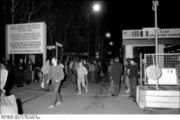
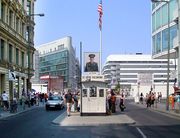
Although the wall opened in November 1989, the checkpoint remained an official crossing for foreigners and diplomats until German reunification in October 1990 when the guard house was removed; it is now on display in the open-air museum of the Allied Museum in Berlin-Zehlendorf[12]. The course of the former wall and border is now marked in the street with a line of cobblestones. A copy of the guard house and sign that once marked the border crossing was later erected where Checkpoint Charlie once stood. It resembles the first guard house erected in 1961, behind a sandbag barrier towards the border. Over the years it was replaced several times by guard houses of different sizes and layouts (see photos). The one removed in 1990 was considerably larger than the first one and had no sandbags.
Near the location of the guard house is the Haus am Checkpoint Charlie, a private museum opened in 1963 by Rainer Hildebrandt, which was augmented with a new building in the 1990s. The two Soldiers (one American and one Russian) represented at the Checkpoint Memorial were both stationed in Berlin during the early 1990s.
Developers tore down the East German checkpoint watchtower in 2000. This famous symbol of the Cold War was removed in a clandestine manner so as to attract a minimum amount of attention. The watchtower, which was the last surviving original Checkpoint Charlie structure, was demolished to make way for offices and shops. The city tried to save the tower but failed as it was not classified as a historic landmark. As of January 2006, nothing has been built at this site and the original proposals for development have been shelved.
Checkpoint Charlie has become one of Berlin's primary tourist attractions. An open-air exhibit was opened in the summer of 2006. Gallery walls along the Friedrichstraße and the Zimmerstraße inform on escape attempts, how the checkpoint was expanded, and its significance as a focal point of Cold War, in particular the facing off of Soviet and American tanks in 1961. An overview of other important memorial sites and museums on the division of Germany and the wall is presented as well. Tourists can have their pictures taken for a fee with actors dressed up as allied military policemen standing in front of the guard house. Several souvenir stands and stores proliferate as well.
Gallery
The Wall goes up
 East German guards checking permits of bus passengers going through the checkpoint in October, just after the Wall went up on 13 August 1961. |
 Bus going through the East Berlin checkpoint. |
 Anti-tank barriers just inside East Berlin. |
 Checks by East German guards. |
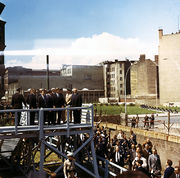 US president John F Kennedy at Checkpoint Charlie in 1963. |
 The Western (foreground) and Eastern (background) checkpoints, with the latter's famous watchtower which was torn down in 2000. |
 Pedestrians crossing the Eastern checkpoint, with the new checkpoint structure being constructed behind in 1984. |
 The Eastern checkpoint in 1988. |
Fall of the Wall
|
People cheering East Berliners driving through Checkpoint Charlie after the fall of the Wall |
East Berliners going west. |
West German children applaud as East German visitors drive through Checkpoint Charlie and take advantage of relaxed travel restrictions to visit the West. |
 Celebrating the Fall of the Wall. |
The checkpoint post-Berlin Wall
 Removal of the famous checkpoint booth on 22 June 1990. |
 The eastern checkpoint being dismantled in November 1990. |
 Checkpoint Charlie in January 1991. |
Getting the souvenir pictures in January 1990 before everything disappears. |
 Remnants of the Wall at Checkpoint Charlie in July 1990. |
The Checkpoint Charlie building at the time of the fall of the Berlin Wall now rests at the AlliiertenMuseum in Berlin-Dahlem. |
"MP" actors for photo hire |
Other uses
- Mention of Checkpoint Charlie in the Elvis Costello song Oliver's Army
- Old CB terminology for a police checkpoint, placed to look for drunk drivers, etc.
See also
- Checkpoint Alpha
- Checkpoint Bravo
- Eastern Bloc emigration and defection
Notes
- ↑ Dowty 1989, p. 114
- ↑ 2.0 2.1 Dowty 1989, p. 121
- ↑ 3.0 3.1 Harrison 2003, p. 99
- ↑ Maddrell, Paul (2006). Spying on Science: Western Intelligence in Divided Germany 1945–1961. Oxford University Press. pp. 56.
- ↑ 5.0 5.1 Dowty 1989, p. 122
- ↑ Thackeray 2004, p. 188
- ↑ 7.0 7.1 Pearson 1998, p. 75
- ↑ 8.0 8.1 8.2 Gedmin, Jeffrey. "The Dilemma of Legitimacy". The hidden hand: Gorbachev and the collapse of East Germany. AEI studies. 554. American Enterprise Institute. pp. 35. ISBN 0844737941, 9780844737942.
- ↑ 9.0 9.1 Dowty 1989, p. 123
- ↑ Dowty 1989, p. 124
- ↑ Black et al. 2000, p. 141
- ↑ "Allied Museum Berlin". http://www.alliiertenmuseum.de/en/3_1_2.php.
References
- Black, Cyril E.; English, Robert D.; Helmreich, Jonathan E.; McAdams, James A. (2000), Rebirth: A Political History of Europe since World War II, Westview Press, ISBN 0813336643
- Dowty, Alan (1989), Closed Borders: The Contemporary Assault on Freedom of Movement, Yale University Press, ISBN 0300044984
- Dowty, Alan (1988), "The Assault on Freedom of Emigration", World Affairs 151 (2)
- Harrison, Hope Millard (2003), Driving the Soviets Up the Wall: Soviet-East German Relations, 1953–1961, Princeton University Press, ISBN 0691096783
- Pearson, Raymond (1998), The Rise and Fall of the Soviet Empire, Macmillan, ISBN 0312174071
- Thackeray, Frank W. (2004), Events that changed Germany, Greenwood Publishing Group, ISBN 0313328145
External links
- Haus am Checkpoint Charlie museum
- Berlin Wall history, by R. Langill
- National Security Archive interviews
- National Security Archive history
- Report claiming crisis began on 25 October. Sources give conflicting accounts of the dates when the tanks arrived at and left Checkpoint Charlie.
- Photo of tanks at Checkpoint Charlie in 1961
- Checkpoint Charlie on Western Allies Berlin website including pictures
- Virtual e-Tour Checkpoint Chalie Shockwave Player required
|
|||||||||||||||||||||||||||||||
